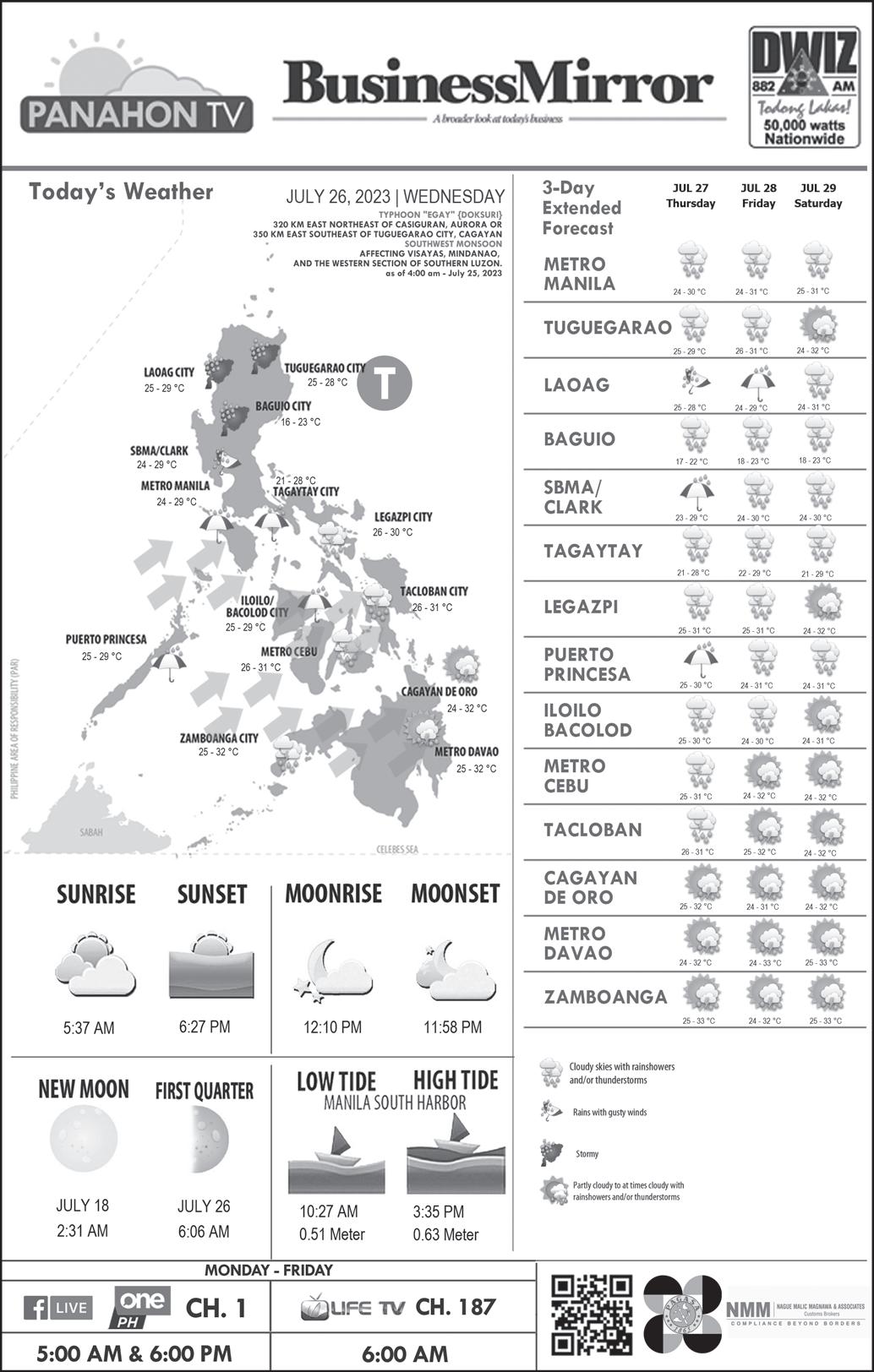
6 minute read
PHL still Asia’s BPO engine, but down in offshoring rank
By Dennis D. Estopace
DOF.
Continued from A1 open he is to the possibility of allowing a slightly higher than 3-percent national government budget deficit goal in light of the possibility of multiple external economic headwinds.
The current administration is eyeing to slash the national government’s budget deficit to just 3 percent of the country’s GDP from 7.3 percent last year.
The report by the global management consulting firm noted that the Philippines continues to be the business process outsourcing (BPO) engine of Asia: it is home to more than 1,000 BPO companies with nearly 1.2 million employees.
“However, it slipped three spots in this year’s GSLI [Global Services Location Index] [from nine to 12], primarily because of the rise of Mexico and Colombia as nearshore capability centers with proximity to the United States,” a statement from Kearney read.
Kearney’s 2023 GSLI “stud - ies the critical factors that make countries attractive as potential locations for offshore services.” The firm said the index helps companies and government institutions understand and compare the factors that make countries attractive as potential locations for offshoring.
“In an era of rapidly evolving global business landscapes, business services like information technology, BPO and engineering are increasingly being delivered across borders as companies seek to reduce costs, scale talent and increase efficiency by utilizing the global talent base,” Kearney’s statement read. “In the current climate, Asia Pacific [APAC] markets shine as potential offshore service destinations, with India, China and Malaysia continuing to lead the index as the top three destinations respectively.”
Kearney said its GSLI ranks 78 countries based on 52 metrics that cover four dimensions that include: financial attractiveness; people skill and availability; business environment; and, digital resonance.
Kearney said that with the growing demand for technologies such as artificial intelligence, machine learning, the Internet of Things and automation, the demand for a skilled workforce in the Philippines is also growing.
“To seize this opportunity, the [Philippine] government offers the Technical Education and Skills Development Authority and a wide range of courses in the BPO sector—from basic customer service to more specialized knowledge such as data analysis and cloud computing,” Kearney said.
The firm noted the establishment last year of a $100-million data center by Digital Edge Ltd. Kearney said this data center is expected to help “bridge the digital divide in Southeast Asia’s most dynamic countries.”
The Philippines, nonetheless, belongs to APAC countries in the top 15 that include Indonesia, Vietnam, Thailand and Singapore. All these countries, to note, are in the top 10 with Singapore jumping 24 ranks from 38th to 14th in this year’s rank.
Kearney said Singapore marked the highest leap by any country included in the GSLI.
Digitalization. . .
Continued from A1
Last month, Diokno expressed optimism that the national government would surpass its revenue target this year given the sustained growth in revenue collections by the national government.
Earlier this month, the BOC reported that its first-half revenue collections rose by 9.43 percent year-on-year to over P430 billion, buoyed by a weaker Philippine peso amid a drop in import volume. (Related story: https://businessmirror.com. ph/2023/07/06/weaker-peso-trumps-import-dip-boc-h1-take-up-9-4/)
Continued from A1
Dakila said in the third quarter of last year, inflation was still increasing and food prices caused inflation to peak at 8.7 percent in January 2023. Inflation has since eased to 5.4 percent in June 2023.
“Our challenge now is inflation. Fortunately, the BSP’s inflation-targeting framework has served us well in the face of unusual supply shocks. We continue to focus on our mandate of price stability and have dedicated our resources and attention in pursuit of this goal,” BSP Governor Eli Remolona Jr. said in a video message on Tuesday.
“Our models tell us that inflation will be within the target range of 2 to 4 percent by the 4th quarter of 2023. This is the range that we think is ideal for an economy like the Philippines when it is growing at full capacity,” he added.
BSP also has other tools to ensure that inflation is kept at bay, he said. This now includes the introduction of the 56-day BSP bills.
The 56-day BSP Bill, which is an additional tenor under the BSP Securities Facility, will be offered alongside the 28-day BSP Bill.
BSP earlier said the 56-day BSP Bill increases its flexibility to respond to changing liquidity conditions while providing additional guidance to short-term market interest rates.
However, last week, BSP said the 28-day and 56-day tenors were undersubscribed. The BSP maintained its total volume offering for the BSP Bill auction at P160 billion, with the allocation between the 28-day and 56-day tenors also retained at P120 billion and P40 billion, respectively.

“What’s good is that we have a number of improvements that we have introduced into our policy instruments that enhance the transmission of these instruments to the market interest rates including the introduction of 56-day BSP Bill,” Dakila said.
“Pretty soon, we will be moving to a variable rate auction for the reverse repurchase [RRP]and all of this will serve to manage any reactions by the market in the interim between those two policy decisions,” he added.
Diokno explained that infrastructure spending remains a top priority of the government, since slowing it down “will only have negative consequences.”
“Like there will be many unfinished projects and you prolong the completion of some projects which would then change the calculation on that net percent value, the internal rate of return and so forth and so on,” he said.
Diokno reiterated that incurring a budget deficit because of infrastructure spending is a “good way” to have a deficit because infrastructure projects allow the economy to grow.
The national government’s budget deficit in May declined by 16.73 percent to P122.2 billion from P146.8 billion in the same month of last year as state revenues outpaced spending, according to the Bureau of the Treasury. (Related story: https://businessmirror.com. ph/2023/06/28/ng-may-budget-gap-dips-16-7/)
This year, the national government expects a budget deficit of nearly P1.5 trillion, or about 6.1 percent of the country’s GDP. Meanwhile, the national government plans to sustain its infrastructure spending between 5 percent and 6 percent until 2028. Jasper Emmanuel Y. Arcalas
DICT ramps up govt digital transformation initiatives
By Lorenz S. Marasigan @lorenzmarasigan
THE Department of Information and Communications Technology (DICT) is ramping up the digital transformation initiatives in the government, as it heeds the call of President Ferdinand Marcos Jr. to bring critical services closer to Filipinos.
A day after the State of the Nation Address (Sona) of President Ferdinand Marcos Jr., the ICT Secretary Ivan Uy said the agency is committed to “accelerate the implementation of its flagship connectivity projects.”
This includes the Broadband ng Masa Program, which integrated the National Broadband Project and the Free WiFi Project into one “comprehensive program.”
“With respect to the National Broadband aspect, we have actually been able to connect Baler from Aurora to Poroc Point in La Union—that will be live probably next month. Then for the Luzon connection from the north, from Ilocos down to Quezon City, we’re projecting that by the end of the year that should be live,” Uy said.
He noted that the DICT is now working towards the utilization of low-orbit satellite connectivity to provide geographically isolated and disadvantaged areas (GIDA) Internet connectivity.
“We now have more options. In the past connecting remote islands and mountain communities has been rather difficult, most modalities are expensive and require the construction of towers, which could be affected by adverse weather, or submarine cables to connect remote islands. With satellite technology, we could bring the cost down significantly while bringing the quality up,” Uy said.
The ICT chief vowed to “redouble” the agency’s efforts to bring reliable broadband connectivity across the Philippine islands.
“Because of the wider options of technology that’s available and because of policy and regulatory changes that we implemented, we do look forward to an increased ability to deploy connectivity at much lower costs and much better reliability across the islands,” Uy said.
The ICT agency will also work with the Department of Transportation (DOTr) and the Department of Tourism (DOT) to identify public areas that need connectivity.
“We’re working together to identify the ports and areas where there will be a need to improve digital connectivity, especially for our tourism areas; our airports, seaports, and transport terminals,” Uy said.
In the enterprise space, Uy said the government expects data center capacity in the Philippines to quintuple by 2025.
“In the next two years, we project at least a 500-percent increase in data center capacity. Hyperscalers are looking at the Philippines as an ideal location for them to host,” he said.
The ICT chief also committed to using AI to “oil the engine” of the economy as well as to leverage data to make smart, scientific decisions and policies.
Marcos said during his Sona that digital transformation remains a priority for his administration, calling on government agencies and local government units to “fully embrace digitalization to provide better service to the people.”








